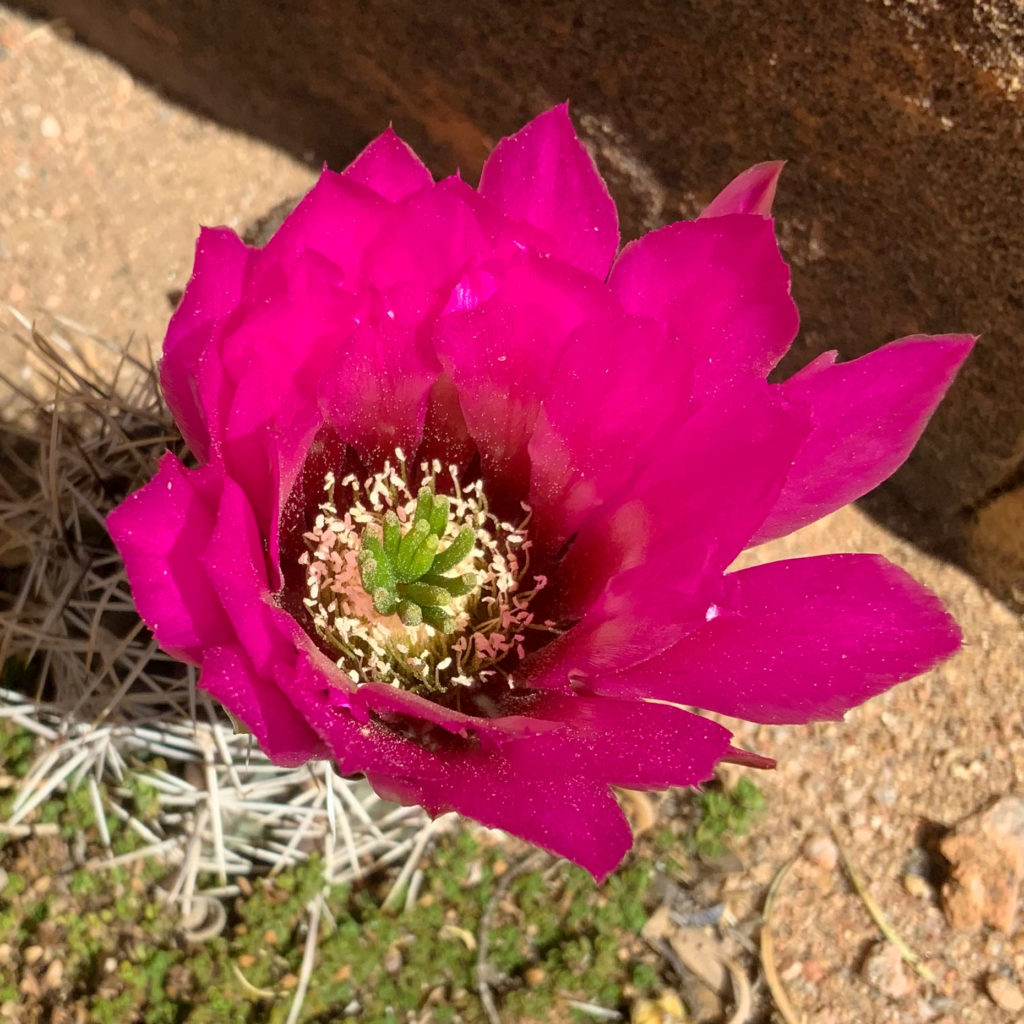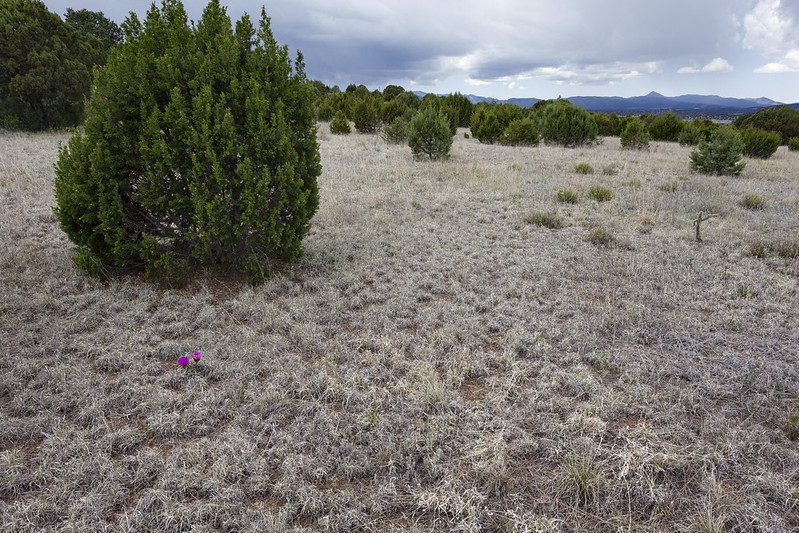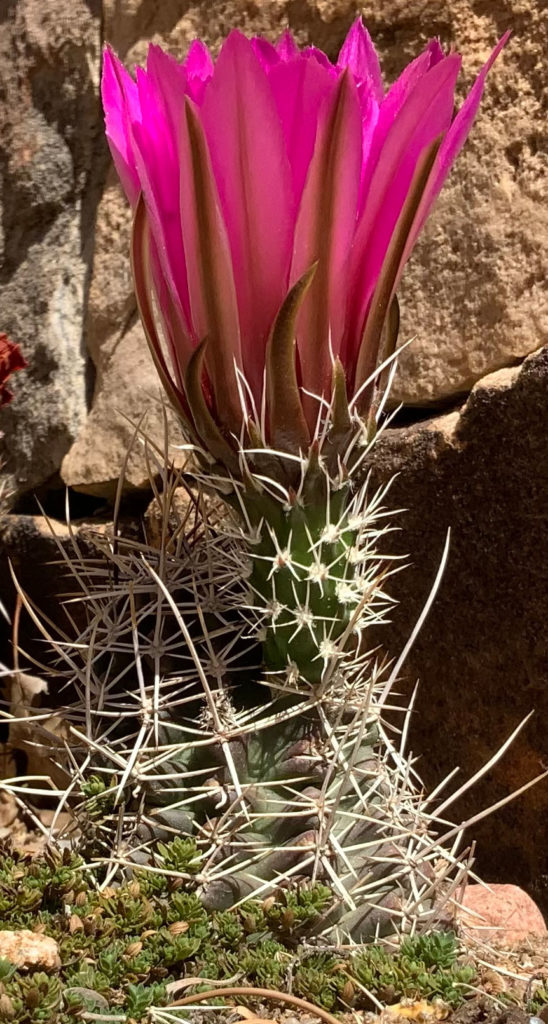Scientific name: Echinocereus fendleri (Engelm.) Small
Plant family: Cactaceae (Cactus)
By Monica Harmon

Echinocereus fendleri in Garden, late May.
A native cactus in New Mexico, pink-flower hedgehog cactus (Echinocereus fendleri) grows in single stems or small clumps to 25 cm tall. It blooms an extraordinarily beautiful magenta flower April to June, after which it produces edible fruits, similar to prickly pear. Evidence of this species has been found at Salmon Ruins with enough abundance to indicate its importance to the Ancestral Puebloans who inhabited this site (Doebley 2016). Its fruits may have been eaten dried or fresh and its stems roasted. Cacti are very resilient, and any severed stems can take root in a new location. Likewise, its seeds may be dispersed by humans and animals who partake of the fruit. Pink-flower hedgehog cactus has some special adaptations to its desert habitat, beyond its succulent growth form and protective spines.

Blue grama and juniper savanna and a plant of pink-flower hedgehog cactus in lower left. Near Ft. Stanton, Lincoln County, New Mexico, 29 May 2017. Photo: Patrick Alexander.
On an unassuming spot, in the middle of the desert, pinkflower hedgehog cactus grows during the day with carbon that it absorbed from our atmosphere overnight. Plants take up carbon through stomata (tiny valves) in their leaves. However, water vapor also exits through these same valves when open. This water-for-carbon trade can be too expensive for a plant with access to little water. The hot, dry desert air under a sweltering sun is a harsh habitat. The desert demands adaptation and cacti certainly look different than other plants.
 First, cacti don’t have what we think of as leaves. Evolutionarily speaking, their spines were leaves that changed functions entirely: now they guard the succulent plant tissue from hungry and thirsty animals. The fleshy, green part of the cactus contains the aforementioned stomata. Cacti, like pinkflower hedgehog cactus, are so well adapted to the desert that they avoid opening their stomata during the day altogether. The evaporative demand (how much water the air can absorb) in a desert is so high that a cactus would risk complete desiccation over the course of one day if it were to open their stomata during the day like non-desert plants. Cacti found their own way: open stomata at night and keep them shut during the day. This seemingly simple solution is a different form of photosynthesis called “CAM photosynthesis”. CAM allows the plant to take up CO2 at night and store carbon overnight. Then, during the day, with stomata safely closed, the cactus can use photons from the sun to make sugars as usual without the risk of drying out. Separating the steps of photosynthesis between night and day means the plant loses its ability to grow quickly. With land-use change damaging the native habitat of a species that grows very slowly, it becomes clear why pinkflower hedgehog cactus populations in the wild are low.
First, cacti don’t have what we think of as leaves. Evolutionarily speaking, their spines were leaves that changed functions entirely: now they guard the succulent plant tissue from hungry and thirsty animals. The fleshy, green part of the cactus contains the aforementioned stomata. Cacti, like pinkflower hedgehog cactus, are so well adapted to the desert that they avoid opening their stomata during the day altogether. The evaporative demand (how much water the air can absorb) in a desert is so high that a cactus would risk complete desiccation over the course of one day if it were to open their stomata during the day like non-desert plants. Cacti found their own way: open stomata at night and keep them shut during the day. This seemingly simple solution is a different form of photosynthesis called “CAM photosynthesis”. CAM allows the plant to take up CO2 at night and store carbon overnight. Then, during the day, with stomata safely closed, the cactus can use photons from the sun to make sugars as usual without the risk of drying out. Separating the steps of photosynthesis between night and day means the plant loses its ability to grow quickly. With land-use change damaging the native habitat of a species that grows very slowly, it becomes clear why pinkflower hedgehog cactus populations in the wild are low.
Unfortunately, this species is listed as endangered. But through this listing, the species becomes a priority for conservation and monitoring. It occurs not only in New Mexico but across Arizona, Colorado, Texas and Mexico (in Chihuahua and Sonora states). It can grow at elevations approaching 8000 feet above sea level. It grows among pinyon-juniper, among mesquite but also in grasslands and interior chapparal. It can be found at the Santa Fe Botanical Garden in the Xeric Garden Hot Boxes NE and NW. Identifying this plant in the wild may prove challenging as it shares its habitat with other similar species in the same genus, and possibly hybridizes (cross-breeds) with these individuals as well. If you find yourself hiking and looking, look for pink-flower hedgehog cactus on south-facing slopes. It can be distinguished from the similar Echinocereus coccineus by its flower color: E. coccineus flowers will be red to orange and never purple/magenta. The growth form between these two species is also slightly different where E. coccineus stems are tightly packed into a mound where pinkflower hedgehog may have solitary stems or otherwise stems not so tightly packed together. You may need some patience to find this species. Ultimately it may require you to spend more time hiking in the desert, which sounds enjoyable regardless.
Works cited
John F. Doebley (1981) Plant Remains Recovered by Flotation from Trash at Salmon Ruin, New Mexico, KIVA, 46:3, 169-187, DOI: 10.1080/00231940.1981.11757954


